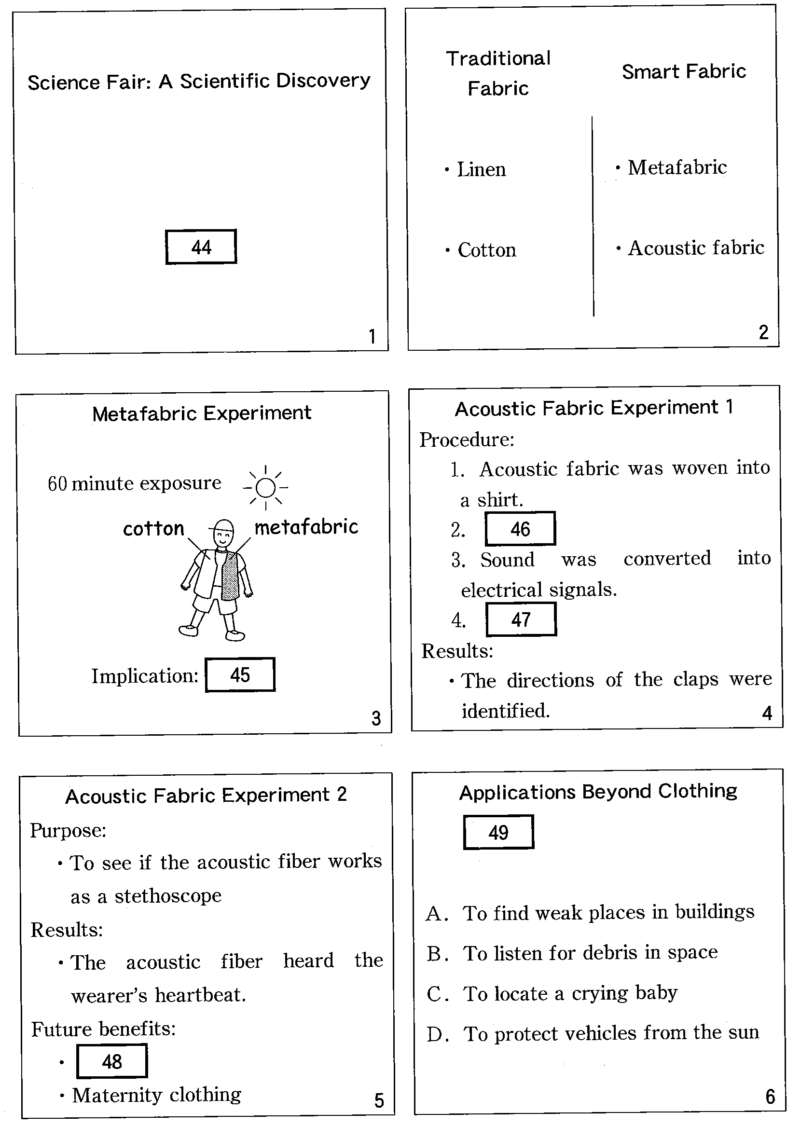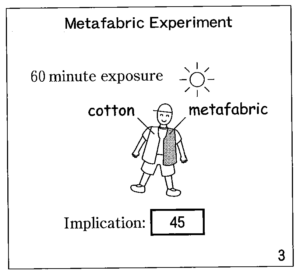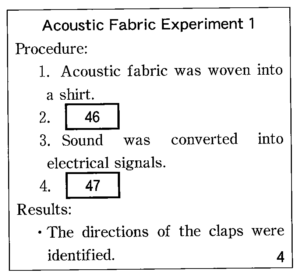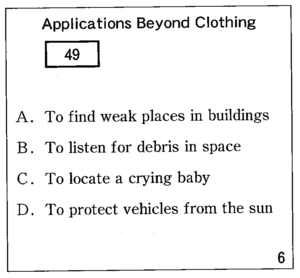2024年度の大学入学共通テスト追試験英語第6問Bの解説をしています。疑問点が残らないよう、解き方の手順も踏まえて一問一問どこよりも丁寧に説明します。
問題
You are preparing for a science fair presentation on a scientific discovery, using the following magazine article.
“Smart” Fabrics
Through the years, the fabrics we use have evolved to suit our changing lifestyles and needs. Linen, made from the fibers of a plant called flax, is one of the oldest textiles in the world. It naturally reflects away the sun and its intense heat, and allows better airflow than other types of fabric. Light and airy, linen has long been the ideal fabric for warm climates. With industrialization and population growth, however, cotton became more commonly used since it was suitable for mass production. Cloth made from cotton can be heavy and can trap body hear though, which may make people feel uncomfortable in very hot humid weather.
Newer materials are always being developed as technology progresses, and “smart” fabrics are a recent scientific breakthrough in the textile industry. Weaving flexible synthetic fibers into cloth can provide additional functions for the fabric. For example, scientists at the Huazhong University of Science and Technology made a new fabric called “metafabric” that deflects heat to keep people cooler. Such fabric can be used to create clothes that ease the discomfort people suffer when the temperature rises. In their experiment, a participant wore a vest consisting of two halves─one half cotton and the other half metafabric─and was exposed to direct sunlight for an hour. Underneath the cotton, the skin temperature soared to 37℃. In contrast, underneath the metafabric, the temperature rose by just one degree, from 31℃ to 32℃.
Another interesting example is a fabric that can detect sounds. The human ear picks up sound pressures, and the inner organs convert sound waves into mechanical vibrations and then into electrical signals. Similarly, “piezoelectric materials,” which are typically used for microphones or speakers, produce an electrical signal when mechanically bent.
Using this knowledge, a team of researchers at the Massachusetts Institute of Technology and the Rhode Island School of Desigh came up with a so-called “acoustic fabric.” The researchers wove a piezoelectric fiber into fabric and conducted a series of experiments. One experiment examined the fabric’s sensitivity to sound directions. They sewed two pieces of acoustic fabric onto the back of a shirt. Then, they clapped their hands at various angles away from the shirt. The fiber converted the sound first into mechanical vibrations, then into electrical signals that were stored on a device. The fabric was successfully able to pinpoint the angle of the sounds. This could lead to a useful application for individuals with hearing aids to identify the direction of a specific sound even in noisy surroundings.
In addition to functioning as wearable hearing aids, acoustic fabric can be used for other purposes such as tracking respiratory (lung), pulse, and cardiac (heart) conditions. Another experiment tested whether clothes with acoustic fibers could act as fabric stethoscopes to monitor a person’s subtle cardiac features. The research group attached a single fiber over the chest region on a shirt and found it accurately detected the wearer’s heart signals. Furthermore, this result indicated the possibility of utilizing the fabric in maternity clothes to check an unborn baby’s heartbeat.
Researchers see applications of smart fabrics beyond clothing. A smart fabric with cooling performance can be applied to various products for different purpose, such as tents, car covers, curtains, and sunshade products. Acoustic fabrics can be integrated with spacecraft coatings to monitor cosmic debris, or be used to help detect cracks or strains in buildings. They can even be woven into a net to check on fish in the sea.
As these examples of textile innovation suggest, new fabrics can enhance our lives in many ways. You may not believe this, but the coolest things about these fabrics are that you can get “smart” while wearing them and some of them are machine-washable!
Your slides:

問1 Which is the best title for the presentation on Slide 1?
- Bio-Based Textile Innovation
- First Fabric That Addresses New Challenges
- Great Advantages of Clever Textiles
- The History of Fiber Design
問2 What does the result of the experiment by the Huazhong University of Science and Technology imply on Slide 3? Choose the best option for ( 45 ).
- It is far easier to create an outfit that keeps you warm.
- Light-colored fabric is more suitable for reflecting the sunlight.
- The newly invented fabrics can keep people comfortable in hot weather.
- You should wear a shirt made of the metafabric over your other clothing.
問3 You are summarizing the steps in conducting the acoustic study on the smart shirt on Slide 4. Choose the best options for ( 46 ) and ( 47 ).
- Mechanical vibrations were bent by the fabric
- Sounds from various directions were made.
- The acoustic fabric recorded the sounds.
- The output from each fiber was saved.
- The researchers moved a shirt to defferent places.
- Various types of sounds were measured by a shirt.
問4 What can be inferred as a possible benefit of wearing an acoustic fabric on Slide 5? Choose the best option for ( 48 ).
- A person with irregular cardiac activity can get help.
- Acoustic fabric can give a person direction on the street.
- It can help a person breathe more deeply and easily.
- It can reduce noise levels and answer phone calls.
問5 You found an error on Slide 6. Which of the following should you remove?
- A
- B
- C
- D
解説 問1
Which is the best title for the presentation on Slide 1?
プレゼンテーションのスライド1に最適なタイトルはどれですか。
このプレゼンテーションのタイトルを、選択肢から選ぶ問題ですね。選択肢を確認しましょう。
1. Bio-Based Textile Innovation
バイオベース繊維の革新
本文に出てくる Linen や Cotton は「バイオベース」繊維ですが、Metafabric や Acoustic fabric はそうではありません。この選択肢は違います。
2. First Fabric That Addresses New Challenges
新たな課題に取り組む最初の布
新素材の布を使って、様々な課題に挑むという話ではあります。ですが新素材として metafabric や acoustic fabric という少なくとも2種類の Fabric が出てきていますから、選択肢の「First Fabric」はふさわしくありません。この選択肢は違います。
3. Great Advantages of Clever Textiles
優れた繊維のすごい利点
スライド2では Smart Fabric として metafabric と acoustic fabric をあげています。そしてスライド3では metafabric の、スライド4と5では acoustic fabric の利点について述べています。この選択肢が正解です。
4. The History of Fiber Design
繊維デザインの歴史
繊維の歴史についての話はありましたが、「デザイン」には触れられていません。この選択肢は違います。
ということで、正解は「3」です。

スライド1には「Science Fair: A Scientific Discovery / サイエンスフェア: 科学的な発見」とあります。そこから考えることも出来そうですね。プレゼンテーションのタイトルですから、すべてを読んでから最後に取り組むのがよさそうです。
解説 問2
What does the result of the experiment by the Huazhong University of Science and Technology imply on Slide 3? Choose the best option for ( 45 ).
スライド3の華中科技大学の実験結果は何を意味していますか。( 45 )に最も適した選択肢を選択してください。
スライド3はこれです。

cotton と metafabric を半分ずつ身に着けて、60分間太陽の下にいた結果どうなるかという実験ですね。その実験は第二段落にあります。それを踏まえて選択肢を確認しましょう。
1. It is far easier to create an outfit that keeps you warm.
暖かく保つ服を作るのはずっと簡単です。
第一段落にこうあります。
With industrialization and population growth, however, cotton became more commonly used since it was suitable for mass production. Cloth made from cotton can be heavy and can trap body heat though, which may make people feel uncomfortable in very hot humid weather.
しかし、工業化と人口増加に伴い、大量生産に適していた綿が一般的に使用されるようになりました。綿で作られた布地は重く、体の熱を閉じ込める可能性があるため、非常に暑く湿度の高い天候では不快に感じるかもしれません。
この部分を読み取ると、確かに「cotton / 綿」は保温効果があります。また、大量生産に適しているのは、その服を作るのが簡単だということに繋がります。
ですが今回は、スライド3に適するものを選ぶ問題です。cotton と metafabric の比較実験は、第二段落の内容ですから、この選択肢はスライド3に入れるのには適しません。この選択肢は違います。
2. Light-colored fabric is more suitable for reflecting the sunlight.
明るい色の生地は日光を反射するのに適しています。
リネンやメタファブリックが熱を反射すると本文にありますが、その色については書かれてありません。この選択肢は違います。
3. The newly invented fabrics can keep people comfortable in hot weather.
新しく発明された生地は暑い天候でも人々を快適に保ちます。
cotton と metafabric を使った実験について、第二段落にこうあります。
In their experiment, a participant wore a vest consisting of two halves─one half cotton and the other half metafabric─and was exposed to direct sunlight for an hour. Underneath the cotton, the skin temperature soared to 37℃. In contrast, underneath the metafabric, the temperature rose by just one degree, from 31℃ to 32℃.
実験では、被験者が半分が綿、もう半分がメタファブリックの2つの半分でできたベストを着用し、1時間直射日光にさらされました。綿の下では、皮膚温度が37℃まで上昇しました。対照的に、メタファブリックの下では、温度は31℃から32℃に1℃しか上昇しませんでした。
その前にはこう書かれてあります。
For example, scientists at the Huazhong University of Science and Technology made a new fabric called “metafabric” that deflects heat to keep people cooler. Such fabric can be used to create clothes that ease the discomfort people suffer when the temperature rises.
たとえば、華中科技大学の科学者は、熱を反射して人々を涼しく保つ「メタファブリック」と呼ばれる新しい布地を作りました。このような布地は、気温が上昇したときに人々が感じる不快感を和らげる衣服を作るのに使用できます。
metafabtic は、暑い天候下でも温度があまり上がらず、不快感を和もげます。ということで、この選択肢が正解です。
4. You should wear a shirt made of the metafabric over your other clothing.
metafabtic で作られたシャツを、他の服の上に着るべきです。
metafabtic は熱を反射しますから、下着にするよりは上着にする方がよさそうです。ですが暑さを和らげるには、肌着として使うのが普通でしょう。また本文にも、上に着るべきというような記述はありません。この選択肢は違います。
ということで、正解は「3」です。

暑い日には「黒」よりも「白」の方がいいというのは、一般常識として良く知られています。その点で選択肢「2」に書かれてある内容自体は間違っていません。ただ、スライド3は cotton と metafabric の比較実験ですから、色の明るさは今回の問題は関係ありませんね。
解説 問3
You are summarizing the steps in conducting the acoustic study on the smart shirt on Slide 4. Choose the best options for ( 46 ) and ( 47 ).
スライド 4 では、スマート シャツの音響調査を行う手順をまとめています。( 46 )と( 47 )に最適な選択肢を選択してください。
スライド4はこれです。

Acoustic Fabric の実験手順の空欄に入る選択肢を選ぶ問題です。Acoustic Fabric の実験手順は、本文によると次のように書いてあります。まずは第四段落にこうあります。
They sewed two pieces of acoustic fabric onto the back of a shirt.
彼らはシャツの背中に2枚の acoustic fabric を縫い付けました。
これはスライド4の「1」の内容です。
1. Acoustic fabric was woven into a shirt.
acoustic fabric をシャツに織り込んだ。
第四段落の続きにこうあります。
Then, they clapped their hands at various angles away from the shirt.
次に、シャツから離れたさまざまな角度で手を叩きました。
これがスライド4の( 46 )に入る部分です。該当する選択肢は「2」です。
2. Sounds from various directions were made.
さまざまな方向から音が発せられました。
第四段落の続きにこうあります。
The fiber converted the sound first into mechanical vibrations,
繊維は音を最初に力学的な的振動に変換しました
これはスライド4の「3」の内容です。
3. Sound was converted into electrical signals.
音は電気信号に変換された。
第四段落の続きにこうあります。
then into electrical signals that were stored on a device.
次にデバイスに保存される電気信号に変換しました。
これはスライド4の( 47 )に入る部分です。該当する選択肢は「4」です。
4. The output from each fiber was saved.
各繊維からの出力が保存されました。
これで正解は分かりましたが、念のため他の選択肢についても確認てみましょう。
1. Mechanical vibrations were bent by the fabric
力学的な振動が布によって曲げられました
bent について、第三段落にこうあります。
Similarly, “piezoelectric materials,” which are typically used for microphones or speakers, produce an electrical signal when mechanically bent.
同様に、マイクやスピーカーによく使用される「圧電材料」は、力学的に曲げられると電気信号を生成します。
piezoelectric material が曲がると電気信号が発生するのであって、振動が曲がるのではありません。そもそも選択肢に書いてある「振動が曲がる」ということ自体意味が良くわかりません。この選択肢は違います。
3. The acoustic fabric recorded the sounds.
acoustic fabric が音を記録しました。
第三段落にこうあります。
The fiber converted the sound first into mechanical vibrations, then into electrical signals that were stored on a device.
繊維は音を最初に力学的な振動に変換し、次にデバイスに保存される電気信号に変換しました。
acoustic fabric は音を記録するのではなく、音を電気信号に変換します。この選択肢は違います。
5. The researchers moved a shirt to defferent places.
研究者はシャツをさまざまな場所に移動しました。
第三段落にこうあります。
Then, they clapped their hands at various angles away from the shirt.
次に、シャツから離れたさまざまな角度で手を叩きました。
シャツを移動させるのではなく、手をたたく人の方が移動しています。この選択肢は違います。
6. Various types of sounds were measured by a shirt.
シャツによってさまざまな種類の音が測定されました。
今回は手をたたいて実験をしています。つまりそこで測定された音は、手をたたいた音だけです。様々な音ではありません。この選択肢は違います。
つまり「1」「3」「5」「6」は、スライド4の空欄には不適当です。ということで、( 46 )→「2」、( 47 )→「4」です。

ありえない選択肢を先に消してから考えると選びやすそうです。「1」「3」は常識的に考えて変ですから、本文の内容と関係なく消すことができますね。
解説 問4
What can be inferred as a possible benefit of wearing an acoustic fabric on Slide 5? Choose the best option for ( 48 ).
スライド5で、acoustic fabric を着用することの利点として何が推測できますか。( 48 )に最適な選択肢を選択してください。
スライド5はこれです。

「Futher benefit / その他の利点」として、「Maternity clothing / マタニティウェア」とともに示されるべきものを選択肢から選ぶ問題です。
1. A person with irregular cardiac activity can get help.
不整脈のある人は助けを得ることができます。
cardiac について、第五段落にこうあります。
Another experiment tested whether clothes with acoustic fibers could act as fabric stethoscopes to monitor a person’s subtle cardiac features. The research group attached a single fiber over the chest region on a shirt and found it accurately detected the wearer’s heart signals
別の実験では、acoustic fibers を使用した衣服が布製の聴診器として機能し、人の微妙な心臓の特徴を監視できるかどうかをテストしました。研究グループは、シャツの胸部に1本の繊維を取り付け、着用者の心臓信号を正確に検出しました。
Acoustic Fabric を使って心臓の音を聞くことができます。これを使えば不整脈の兆候を早めに知ることができ、適切な対処ができます。この選択肢が正解です。
2. Acoustic fabric can give a person direction on the street.
Acoustic fabric は、路上で人に道を教えることができます。
direction について、第四段落にこうあります。
This could lead to a useful application for individuals with hearing aids to identify the direction of a specific sound even in noisy surroundings.
これは、補聴器を装着した人が騒がしい環境でも特定の音の方向を特定できる便利なアプリケーションにつながる可能性があります。
Acoustic fabric によって、「identify the direction / 方向を特定する」ことはできますが、「give a person direction / 方向を与える→道を教える」ことはできません。この選択肢は違います。
3. It can help a person breathe more deeply and easily.
呼吸を深く楽にすることができます。
第五段落にこうあります。
In addition to functioning as wearable hearing aids, acoustic fabric can be used for other purposes such as tracking respiratory (lung), pulse, and cardiac (heart) conditions.
ウェアラブル補聴器として機能することに加えて、acoustic fabric は「respiratory / 肺」「pulse / 脈拍」「 cardiac / 心臓」の状態を追跡するなどの他の目的にも使用できます。
acoustic fabric は呼吸の状態を追跡できます。しかし、呼吸を深く楽にすることはできません。この選択肢は違います。
4. It can reduce noise levels and answer phone calls.
騒音レベルを下げ、電話に応答することができます。
noise について、第四段落にこうあります。
This could lead to a useful application for individuals with hearing aids to identify the direction of a specific sound even in noisy surroundings.
これは、補聴器を装着した人が騒がしい環境でも特別な音の方向を特定できる便利なアプリケーションにつながる可能性があります。
これは、acoustic fabric が騒音の中でも特別な音を特定できるという話です。acoustic fabric 自体が、騒音のレベルを下げることはできません。この選択肢は違います。
ということで、正解は「1」です。

Acoustic fabric は「音を検知する布」です。それを踏まえて考えると、「1」以外の選択肢の内容は、Acoustic fabric の専門外です。この問題は、消去法で考えるのがやりやすいのではないかと思います。
解説 問5
You found an error on Slide 6. Which of the following should you remove?
スライド6に間違いが見つかりました。次のどれを削除する必要がありますか。
スライド6はこれです。

A~Dのリストの中から不適切なものを選ぶ問題です。選択肢を確認しましょう。
A. To find weak places in buildings
建物の弱い場所を見つける
「建物」について、第六段落にこうあります。
or be used to help detect cracks or strains in buildings.
(Acoustic fabrics は)建物のひび割れや負荷を検出するために使用したりできます。
本文の「cracks / ひび割れ」や「strains / 負荷」が、選択肢の「weak places / 弱い場所」に対応しています。これは正しいリストです。
B. To listen for debris in space
宇宙でのがれきに耳を傾ける
「debris in space / 宇宙のがれき」について、第六段落にこうあります。
Acoustic fabrics can be integrated with spacecraft coatings to monitor cosmic debris,
Acoustic fabrics は宇宙船のコーティングと統合して宇宙のがれきを監視できます。
debris の動向を監視することを、選択肢では「耳を傾ける」と言っています。これは正しいリストです。
C. To locate a crying baby
泣いている赤ん坊の位置を突き止める
「baby」について、第六段落にこうあります。
Furthermore, this result indicated the possibility of utilizing the fabric in maternity clothes to check an unborn baby’s heartbeat.
さらに、この結果は、マタニティウェアに布地を使用して胎児の心拍をチェックできる可能性を示しました。
「baby」に関しては、心拍をチェックするために使います。その位置を突き止めるためには使っていません。これが間違いのリストです。
D. To protect vehicles from the sun
太陽から乗り物を守る
第六段落にこうあります。
A smart fabric with cooling performance can be applied to various products for different purpose, such as tents, car covers, curtains, and sunshade products.
冷却性能を備えたスマート ファブリックは、テント、車のカバー、カーテン、日よけ製品など、さまざまな目的の製品に応用できます。
「車のカバー」や「日よけ製品」が、選択肢の内容に当てはまります。これは正しいリストです。
つまり削除するべきものは「C」です。ということで、正解は「3」です。

第四段落の実験から考えると、リストCの「泣いている赤ん坊の位置を突き止める」目的にも、新素材の服は使えるかもしれません。ですがそれについて本文に直接書かれていないことと、他のリストは言い換えなどありますが、本文にその記述がありますから、削除すべきは「C」となります。




コメントをどうぞ